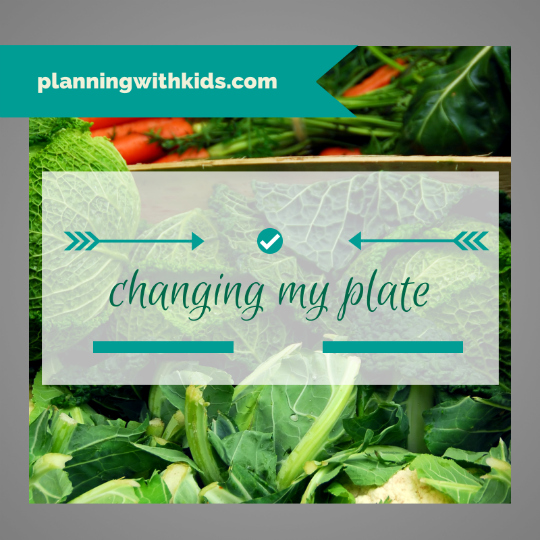This post is part of a regular series focusing on making small changes to improve our health. I shared my journey with changing my diet and moving to a clean eating approach which you can read here. I also had the lovely Katie Rainbird from Katie 180 undertake an analysis of my food intake for one day in that post, which was another step in the right direction.
Together we also offered the same opportunity to readers of Planning With Kids. We were blown away with the response and while I can’t guarantee will get to all of them this year, Katie has been busy working on many of the submissions already and we will publish as many as we can.
It is not possible for Katie to cover off everything in these posts. The aim is for her to find some small things you can change to what you are putting on your plate to help you achieve your current goal for your eating habits. You can read previous Changing my plate posts by clicking here.
Changing my plate – Kate’s day
 Katie Rainbird (AKA Katie180) is a Sydney-based Nutritionist who is just as likely to be found jogging as she is baking. She is a mother to two, a keen home cook, prefers to get around in her workout gear and has a major passion for the written word. You can learn more at www.katie180.com.au.
Katie Rainbird (AKA Katie180) is a Sydney-based Nutritionist who is just as likely to be found jogging as she is baking. She is a mother to two, a keen home cook, prefers to get around in her workout gear and has a major passion for the written word. You can learn more at www.katie180.com.au.
Katie reviewed what a reader Kate submitted that she ate in a 24 hour period. This is what Katie had to say about her day:
What is your current goal with your eating habits?
With 3 young children, my own nutrition has become very neglected – like many others perhaps! I am a snacker and have always eaten little and often, but know what I now eat is usually not the best choice. And contributes to my lack of energy – including the effort needed to improve what I eat. As I get older it becomes more about good health and energy: high salt and sugar plus a lack of nutrients are my main concern. As seen below, convenience features highly in what I eat! More fresh fruit and vegetables are just the beginning I suspect……!?!!
Breakfast
At home – 2 pieces of wheatmeal toast with honey (no butter). Cup of decaf coffee with milk.
Easiest way to improve your bread is to buy sourdough, the fermentation process assists its digestion and its usually very minimal in ingredients. You can afford to use butter, it’s a nourishing saturated fat and will increase the satiety of your meal. Further, you could use cottage cheese or ricotta instead of butter and this will bump up the protein also.
Lunch
At home – cheese on toast with ham, tomato and (store bought) fruit relish. 3 slices of wheatmeal bread.
Try having pre-cooked grains in the fridge, such as brown rice, quinoa, pearled barley, organic tinned lentils and beans and then mix them with diced salad ingredients and ham for a cold meal or leftover roast vegetables with some feta or tzatziki. You can make big trays of mixed roast vegetables ahead of time and keep them in the fridge for use this way or in wraps, sandwiches and as an omelet filling.
Dinner
Dinner at home at 6pm – chicken wraps: oven-baked crumbed chicken tenderloins (from Coles), lettuce, tomato, cucumber, carrot, red pepper. White wrap bread and sweet chilli sauce. Corn on the cob with salt and black pepper.
Avoid buying pre-crumbed and other such flavoured cuts of meat as they often contain additives and preservatives. Rather buy free range chicken drumsticks which are usually pretty reasonably priced and marinate them in some honey and soy sauce or just bake them with olive oil and basic seasoning then serve whole or shred and use for something like this wraps meal. This is something you can prepare ahead of time or prepare in bulk to use for your own leftovers lunch also.
Snack 1
Mid morning – store bought toasted muesli with diced pear in juice.
After walking to school/kinder drop-off (2.5km)
If you’re going to eat tinned fruit, choose the “natural” variety as it’s not in an additionally sweetened juice. Choose a raw muesli rather than a toasted muesli when buying supermarket varieties as its often toasted in vegetable oils and has lots of added sweetener. OR make your own using your favourite nuts, seeds and dried fruit along with whole rolled oats. Add a dollop of full fat, plain yogurt for a protein hit.
Snack 2
Early afternoon – about 8 rice crackers, an apple, small box of sultanas (with my toddler)
See if you can swap from rice crackers to rice cakes for these three reasons: 1. Rice crackers are not just rice, read the ingredients, OMG! 2. They are made with vegetable oil. 3. Not organic. Pure Harvest rice cakes are just organic rice. You can quarter them for little people to eat and use them to dip into humus or salsa. Or spread with peanut butter, cottage cheese, ricotta, spread with Danish feta, sliced tasty cheese and sweet mustard pickles.
Snack 3
After school – 3 chocolate chip cookies (homemade)
Make this two.
Snack 4
Evening – 2 packets of healtheries rice wheels (for kids!)
Swap to a handful of raw nuts and 2 dates. Also a cup of herbal tea – a big one to fill you up.
Dessert
Vanilla yogurt, chopped apple, mandarin, grapes. Hot chocolate made with milk. Yes – I eat something sweet every night.
Choose either the yoghurt OR the hot chocolate and whichever you don’t have, replace it with a healthier alternative so for eg if you have the yoghurt then have a herbal tea instead of the hot chocolate. And if you have the hot chocolate have just a piece of fruit, not the fruit/yoghurt combination. If you want to make a more “mealy” hot chocolate, make it on a nut milk/coconut milk combination using sugar free cocoa and sweeten with vanilla extract, maple syrup or honey.
Nutritional supplements
Nil
With three young kids you may benefit from supplementing with something like Ethical Nutrients Mega Magnesium Powder for energy production and the central nervous system.
Daily fluid intake
2 glasses of water in the morning.
Cup of decaf coffee with milk.
3 diet cokes. Or 4.
A million cups of tea with milk (about 8?)
1 large skinny latte (about 4 times a week)
Any further information you’d like to share or special dietary requirements to factor in?
I’m not a vegetarian but very rarely eat red meat. I make stir-fries rather than cook steaks or roasts as I find heavier meat dishes don’t agree with my digestive system. We eat a lot of rice + chicken type dishes, and while I cook pasta for the kids I don’t really eat it myself.
Katie’s Summary
THREE MAIN THINGS: 1. Reduce intake of coke, increase intake of water and caffeine alternatives. 2. Swap grains and grain products for whole-grain varieties. 3. Prepare food that can travel across a few meals so that you have heartier leftover lunches.
Further reading and recipes
- Meatless Monday ~ Roasted Pumpkin Soup
- Roasted Eggplant Dip
- Toasted quinoa and peanut bars
- Baked Porridge
- {Not} Cherry Ripe Bars
Disclaimer
Katie is a qualified nutritionist (Adv. Dip. Nutr. Med.).
Any diet or lifestyle changes that you implement as a result of reading this blog are your own responsibility.
This blog does not provide medical advice, any particular health conditions must be managed by your own health professional.
The content of this blog is not intended to be a substitute for professional medical advice, diagnosis or treatment.
Always seek the advice of your physician or other qualified health provider with any questions you may have regarding a medical condition. Never disregard professional medical advice or delay in seeking it because of something you have read on this blog.

